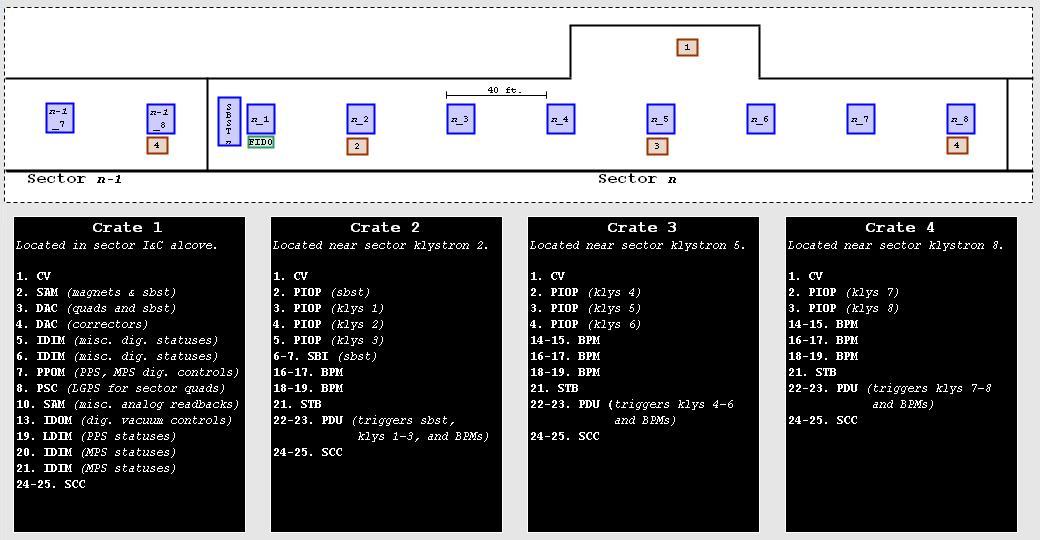- Site Intro
- Sector Pair
- Subbooster System
- Klystron System
- Camac System
- Definitions
- References
- Acknowledgements
CAMAC Diagram

Notes:
The above diagram shows the klystron gallery locations of the four CAMAC crates in a typical sector, and the boxes below the diagram lists the standard modules they contain. CAMAC stands for Computer Automated Measurement and Control. A CAMAC crate has 25 available slots for modules, and some modules require more than one slot. Operators can remotely determine the contents of any given crate using the CAMDMP function in the Network & Micro Index on the SCP. Modules that do not show up on CAMDMP are the Crate Verifier (CV), which occupies the first slot of every crate; the Serial Crate Controller (SCC), which always occupies slots 24 and 25; and the Simple Timing Buffer (STB), which is located next to every PDU. More information about the functions of most of the modules discussed here can be found in the Definitions page. Detailed descriptions of all CAMAC modules can be found in the SLC Hardware Manual.
The subbooster and its associated electronics are located at the very beginning of the sector, facing upstream. The eight klystron stations are spaced 40 feet apart down the length of the sector. A rack near each klystron's modulator cabinet holds the MKSU, power supplies, and other control electronics. CAMAC crate 2 is located in the racks at klystron 2; crate 3 is at klystron 5; and crate 4 is at klystron 8. Crate 1 is in the sector's instrumentation and controls (I&C) alcove, on the north side of the gallery.
The FIDO chassis for the sector is mounted in the klystron 1 racks just behind the subbooster, and supplies the timing signal to the PDU module in crates 2 and 3 of that sector, and crate 4 of the previous sector. A PDU module provides timing information to all triggered devices in the same crate. Every PDU has an associated STB module that converts the PDU's signal channels to front-panel NIM pulses. Klystron modulator triggers go through the klystron's associated PIOP module. The PIOPs for klystrons 1-3 are in crate 2, 4-6 are in crate 3, and 7 and 8 are in crate 4. The PIOP for the subbooster and the subbooster interface (SBI) module are located in crate 2. Knowing which devices are associated with a particular FIDO, and the source of the timing information for a given subbooster or klystron, can be very useful for diagnosing timing problems.
There are eight BPMs in a typical sector (some special sectors have more than this), and every BPM has its own CAMAC processor module that is triggered by the PDU.
There is no PDU in Crate 1, because none of the modules in this crate control pulsed devices. Most of the modules that control and monitor statuses of beamline magnets, the MPS, PPS, and vaccuum systems are in this crate.